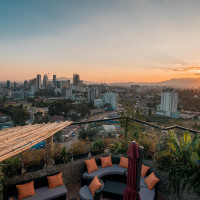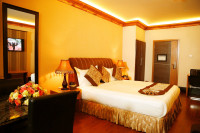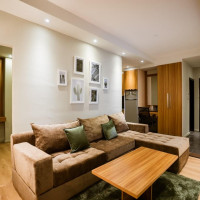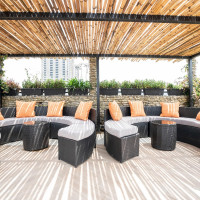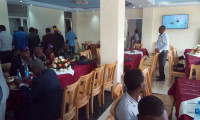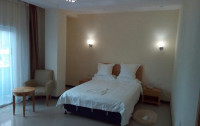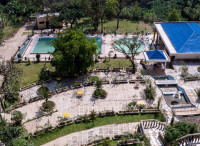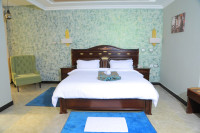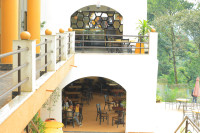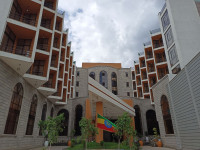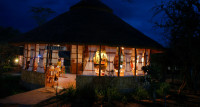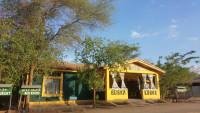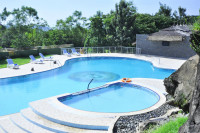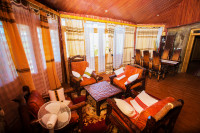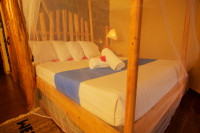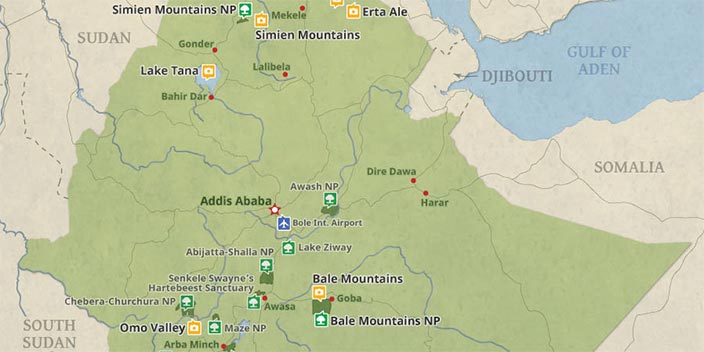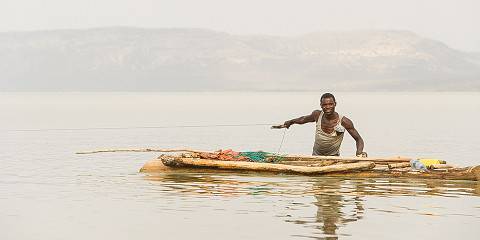
$4,468 pp (USD)
This tour is offered in EUR.
Show rate in EUR
Arrival
Arrival

Day 1
Arrive and City Tour
Arrive and City Tour
Up on your arrival at Bole International Airport and you will clear immigration and proceed to baggage claim, after collecting your checked bags pass through the arrivals hall where you will be meet by tour guide or representative, who will assist you with your transfer to your hotel.
A half day guided tour of the Ethnological Museum, with its artifacts and displays of the cultures and handicrafts of Ethiopia’s many ethnic groups. At the famous National Museum, with its cultural and archaeological relics, you will visit the famous “Lucy,” a 3.2 million-year-old female hominid who was discovered in Ethiopia’s Awash Valley in 1974. The open-air market of Addis, the Mercato, is the largest on the continent, and you will take a drive through it. Time permitting; you may also visit Ba’ata Church, also known as Menelik’s Mausoleum, one of the oldest of the churches in Addis, built in 1911. It houses beautiful paintings and the royal tombs of past emperors, including Emperor Haile Selassie.
- Main Destination:
- Addis Ababa (City)
- Accommodation:
- Monarch Parkview Hotel
- Meals & Drinks:
Day 2
Drive to Jimma
Drive to Jimma
Today you head off in 4WDs towards to the south-west into the Oromo region. Passing by Weliso Maryam church, known for its healing holy water. Drive towards the Gibe River gorge before reaching Jimma. This is the beginning of the Kaffa region which stretches south of the city and it believed to be the home of the Arabica coffee bean. It remains Ethiopia’s main coffee growing area and many farmers still make their living from the coffee plantations which dot the landscape.
- Main Destination:
- Jimma (Town)
- Accommodation:
- Awetu Grand Hotel
- Meals & Drinks:
Day 3
Drive to Mizan Teferi
Drive to Mizan Teferi
You start early in the morning with a visit to King Jaffa’s tin castle overlooking Jimma before driving further South West. Here you enter the heart of the Kaffa region where Kaffa and Bentch agriculturalist live. The latter are known for applying elaborate murals to the exterior of their houses. Stop for lunch in Bonga before passing by the Wush Wush Tea plantation and finally reaching Mizan Tafari where you spend the night.
- Main Destination:
- Mizan Teferi (Town)
- Accommodation:
- Salayish The Grand Hotel and Spa
- Meals & Drinks:
Day 4
Drive Mizan Teferi to Kibish
Drive Mizan Teferi to Kibish
This morning you get up early and take a walk in a traditional Bentch village. Then head out passing through the Bebeka Coffee plantation – the largest in Ethiopia. Heading further south, you reach Dimma, an important transport hub for Suri and Nuer people. From here you enter Suri territory which is surprisingly lush and contains several ecological zones important to Suri lifestyle. You descend into the Kibbish area where (we hope) we spend the next three nights camping at the small village of Regia.
- Main Destination:
- Kibish (Lower Omo Valley)
- Accommodation:
- Budget camping
- Meals & Drinks:
Day 5
Visit Kibish the Suri Tribes
Visit Kibish the Suri Tribes
Spending the day in the area. There is an option to take a walk to Magologne Holy Water and visit a few villages en-route. You will perhaps meet Arbula a former master of Sagine (stick fighting). Sagine takes place when food is plenty and rain is scarce. Several teams from different villages compete against each other and the competition culminates in announcing an overall master. If you are lucky you may witness one of the fights. To Western observers it may appear harsh, but this ritualized form of violence is an essential component of Suri cultural practices.
- Main Destination:
- Kibish (Lower Omo Valley)
- Accommodation:
- Budget camping
- Meals & Drinks:
Day 6
Drive to Omo National Park
Drive to Omo National Park
This morning you say goodbye to your hosts and drive through Nyangatom territory on a rough dirt road after which you enter the remote but beautiful Omo National Park. You look out for game as you drive towards the park’s headquarters at Mui. On arrival, there should be time for a wash and perhaps a drive to the grazing land of the Nyangatom people, a hot spring area and perhaps spot a few antelope species.
- Main Destination:
- Omo National Park (Lower Omo Valley)
- Accommodation:
- Budget camping
- Meals & Drinks:
Day 7
Rafting on Omo River
Rafting on Omo River
This morning you pack and prepare for your 4-day river trip. Your main luggage will remain in the vehicles and you take only minimal belongings with you on the water. Driving deeper into the heart of the park, you finally reach the Omo River which forms the boundaries between Omo National Park and Tama Wildlife Reserve. Today you say goodbye to your cars and drivers and meet your boat captains and rafts which will provide all your transport needs over the next 4 days. Provided that the people have not moved on, you may be camping next to a Mursi village tonight.
- Main Destination:
- Omo National Park (Lower Omo Valley)
- Accommodation:
- Budget camping
- Meals & Drinks:
Day 8
Rafting on Omo River
Rafting on Omo River
Finally your river journey starts in earnest... On your sturdy inflatable rafts with outboard motors, this journey is distinctly “brown-water” and the adrenaline rushes will come from the experience of being on the river and stopping by villages, rather than the surge of the waters. As you slowly make your way down the Omo River there will be plenty time to take in the scenery and indulge in the remoteness of this amazing region. Several ethnic groups inhabit this area and the itinerary is left intentionally free to allow maximum flexibility in this most unpredictable part of the country. The area you travel through today is dominated by the Mursi people who are culturally and linguistically interlinked to the Suri – both known for their lip plates.
- Main Destination:
- Omo National Park (Lower Omo Valley)
- Accommodation:
- Budget camping
- Meals & Drinks:
Day 9
Rafting on Omo River
Rafting on Omo River
Continuing your rafting downstream, we hope to meet members of the Mugugi ethnic group along the river. Further downstream, you now enter the Nyangatom cultural sphere; another semi- nomadic pastoral society. Known to their enemies by the derogatory term ‘Bume’ (the smelly ones), the Nyangatom are proud cattle-herders. Cow’s blood and milk form a major part of their diet and they are traditionally known for body scarifications and elaborate hairstyles symbolizing achievements in fights.
- Main Destination:
- Omo National Park (Lower Omo Valley)
- Accommodation:
- Budget camping
- Meals & Drinks:
Day 10
Rafting On Omo River
Rafting On Omo River
Today is your final day on the river and depending on where you spent last night, you may get to take a walk in a Kara village this morning. The villages are located on the Eastern river bank. The Kara people number a mere 1500 and are culturally interlinked to the Hamer who dominates this part of the lower Omo Valley. After your visit you’ll continue on a short journey to Murelle Camp where you say goodbye to your boat captains and will be met by your drivers, vehicles and main luggage. You make camp for a final night and get to look back with a sense of achievement on the past 4 days on the river.
- Main Destination:
- Omo National Park (Lower Omo Valley)
- Accommodation:
- Budget camping
- Meals & Drinks:

Day 11
Rafting on Omo River
Rafting on Omo River
You begin the morning with a walk in the bush dotted with acacia and desert rose trees before heading into Turmi, a small town and the center of Hamer culture. Then you will drive 73 km west to visit the Dassench /Geleb/ people; who inhabited in the bank of Omo River and we cross the Omo River by locally made boat to see the village these tribes are semi nomadic with very little agriculture on the bank of the Omo River. You will drive back to Turmi in the afternoon. It should be noted that this part of Southern Ethiopia is far more visited than the region you have just left behind. After many nights of camping you have a chance to unwind at a local Lodge.
- Main Destination:
- Lower Omo Valley (Cultural Village)
- Accommodation:
- Buska Lodge
- Meals & Drinks:

Day 12
Visit around Turmi
Visit around Turmi
Turmi is a small Hamer tribes town, the Hamer are one of the most known tribes in Southern Ethiopia. They inhabit the territory east of the Omo River and have villages in Turmi and Dimeka areas. Tourists visit the hamer hoping to see a traditional leaping ceremony called “Bull jumping” it is a ceremony when a boy is pronounced “man” after proving his capacity to jump 5 up to 13 cattle’s stand in a row and the day includes a special event in which a woman shows her appreciation for the bride groom by letting the boys whip them with a stick until they bleed. At night the day is called off after a colorful party with Evangady dance (night dance). If the days are Monday, Tuesday or Saturday we will have a chance to see colorful Market day and as well as Bull jumping ceremony.
- Main Destination:
- Turmi (Lower Omo Valley)
- Accommodation:
- Buska Lodge
- Meals & Drinks:

Day 13
Drive to Aribaminch
Drive to Aribaminch
In the morning driving to Arba Minch. On the way stop at Konso to visit the Konso tribe with their king- UNESCO registered site for their extensive terracing and practice of making a wooden grave mark for their hero and kings. Invariably built on hilltops as protection from the lowland tribes, traditional Konso villages are surrounded by high stonewalls and encompass separate compounds, with outlying terraced agricultural fields. Another highlight is the famous 'wagas' - a funerary tradition where magnificent carved wooden sculptures were created in honor of Konso warrior heroes who have killed an enemy or animal, and often grouped to represent the man, his wives and his adversaries. After lunch we arrive at Lake Chamo. We get there you will take a boat trip in Lake Chamo, to visit the crocodile market, it is a local name for a place in Lake chamo that the crocodiles went out of the lake and chill, there is no buying or selling, also you will see hippos and different kinds of birds.
- Main Destination:
- Arba Minch (City)
- Accommodation:
- Paradise Lodge
- Meals & Drinks:

Day 14
Drive to Addis Ababa and Departure
Drive to Addis Ababa and Departure
After breakfast drive to Dorzy village, this people set high up in the Gughe Mountains where we see the traditional Dorzy beehive shaped huts recognized as one of the visually attractive structural houses. After that start driving back to Addis, on the way visit Tiya, is known for the 10th centuries adjacent archeological site, which is distinguished by 36 standing stones or steal "32 of which are engraved with enigmatic symbols, notably swords," marking a large, prehistoric burial complex. The archeological site was designated a World Heritage Site in 1980 also it listed as world heritage by UNESCO. You will arrive in Addis Ababa late afternoon and you will do some shopping for souvenirs. Finally, you will be taken to a farewell dinner depending on your scheduled your international flight; you will be transferred out to Bole International Airport for return back home.
- Main Destination:
- Addis Ababa (City)
- Accommodation:
- No accommodation (End of tour)
- Meals & Drinks:


